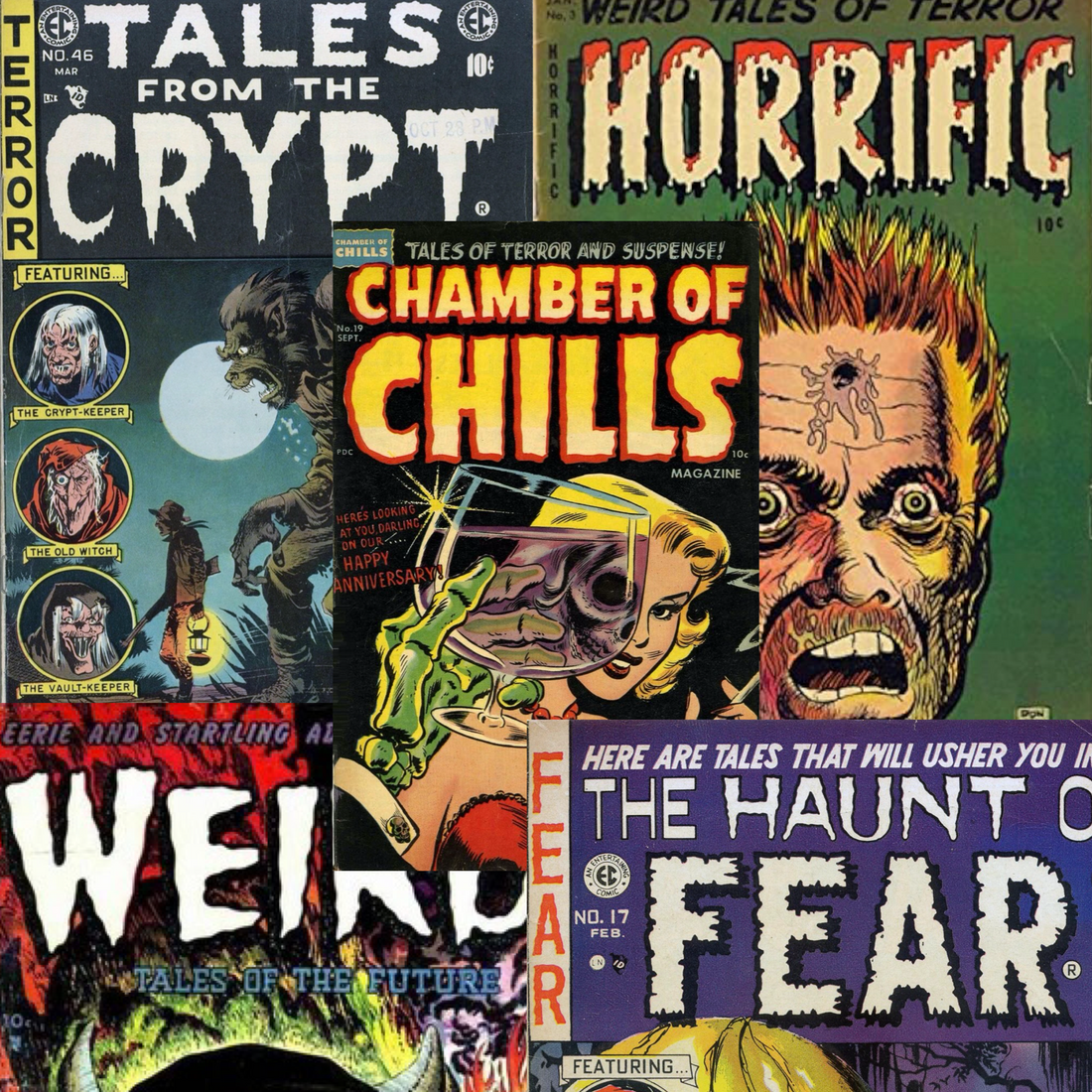
The Spooky Evolution of Horror Comics: From EC to Modern Day Frights
Share
The Origins of Horror Comics: A Spooky Beginning
Horror comics first crept onto the scene in the 1940s, drawing readers into a world of monsters, ghosts, and psychological terror. Publishers like EC Comics introduced iconic titles like "Tales from the Crypt" and "Eerie", bringing macabre stories to life through vivid art and dark storytelling. Al Feldstein, a leading writer for EC Comics, famously said, *“We weren’t just telling horror stories; we were tapping into the primal fears that live in all of us.”* This new approach marked a shift from traditional superhero narratives, making horror comics a unique genre that aimed to unsettle rather than uplift.
The Golden Age: EC Comics' Horror Reign
The 1950s are often hailed as the golden age of horror comics, with EC Comics standing at the helm of the genre. Titles like "The Vault of Horror" and "The Haunt of Fear" showcased gruesome tales of vengeance and terror, often with a sardonic twist. Jack Davis, one of EC’s most prolific artists, once commented, *“We pushed the envelope on what people could handle, and that’s what made horror fun—getting under the skin.”* These stories became beloved by readers but also attracted the ire of critics and moral guardians, as they pushed the boundaries of acceptable content.
Censorship Strikes: The Fall of Horror
The rise of horror comics wasn’t without controversy. In the mid-1950s, a moral panic swept the nation, fueled by Fredric Wertham’s infamous book *Seduction of the Innocent*, which blamed comic books, particularly horror, for corrupting young minds. The outcry led to the creation of the Comics Code Authority (CCA), a regulatory body that imposed strict guidelines on content. William Gaines, EC Comics' publisher, lamented, *“The Code gutted us—it was like putting a muzzle on our creativity.”* With restrictions on depictions of vampires, ghouls, and even “excessive” violence, the horror comic industry was severely stunted.
The 1960s Resurgence: Monsters and Marvels
Despite censorship, horror comics clawed their way back in the 1960s. Publishers like Marvel Comics revived the genre by focusing on classic monsters that skirted the CCA’s regulations. Titles like "The Tomb of Dracula" and "Werewolf by Night" reintroduced readers to supernatural creatures, blending horror with character-driven drama. As Stan Lee put it, *“We brought horror back, but we gave it heart. Dracula wasn’t just a monster—he was a tragic figure burdened by immortality.”* These stories resonated with readers, proving that horror could thrive even under strict censorship.
The Underground Revolution: Breaking the Code
While mainstream comics navigated the restrictions of the CCA, the underground comic scene of the 1960s and 1970s exploded with boundary-pushing horror. Independent creators, free from censorship, published titles that embraced graphic violence, mature themes, and dark satire. Richard Corben, a pioneer of underground horror, described this freedom as *“a chance to take horror back to its roots—unfiltered and raw.”* His work on titles like "Creepy" and "Eerie" became cult classics, showing that the appetite for gruesome and unregulated horror never truly died.
The Modern Renaissance: Horror Comics in the 1980s
The 1980s saw horror comics experience a resurgence, with creators like Alan Moore and Neil Gaiman redefining the genre. Moore’s work on "Swamp Thing" blended horror with environmentalism, while Gaiman’s "The Sandman" explored mythology and nightmares in a way that had never been done before. Moore once remarked, *“Horror is at its best when it reflects the real-world fears we don’t want to face.”* Their innovative approaches expanded the genre, proving that horror could be both intellectually stimulating and deeply unsettling.
Today’s Legacy: Fear Endures in Horror Comics
Horror comics are more popular than ever today, with titles like "The Walking Dead" and "Something is Killing the Children" continuing the tradition of fear and suspense. Creators like James Tynion IV are exploring new ways to scare audiences, blending psychological terror with traditional horror tropes. As Tynion once said, *“Horror is like a living organism—it adapts and changes with each new generation, but its core purpose remains the same: to thrill and terrify.”* Horror comics, much like Halloween itself, have proven that they can evolve while still tapping into our deepest, most primal fears.
Here are five iconic horror comic books that have captivated fans over the years, known for their striking imagery and chilling designs:
1. **"Chamber of Chills #19"** – This cover is one of the most iconic in horror comic history, featuring a haunting, skull-faced figure drinking from a chalice. It’s an image that resonates deeply with horror fans, representing the eerie and macabre themes that defined the genre in the 1950s.

2. **"Tales from the Crypt #46"** – Another EC Comics classic, this cover shows a ghastly scene of horror with a woman on a swing as skeletons look on. EC Comics was known for pushing boundaries, and this cover captures the dark, twisted tone of the stories within.

3. **"Horrific #3"** – This “bullet in the head” cover is notorious for its graphic content and is a favorite among collectors. The shocking imagery of a bullet piercing a man’s head is unforgettable, making it one of the most sought-after pre-Code horror comics.

4. **"Weird Tales of the Future #7"** – Featuring a devilish figure surrounded by flames, this cover by Bernard Baily is a masterclass in creating unsettling, supernatural imagery. It stands out as one of the best examples of how horror comics combined supernatural elements with vivid, striking visuals.

5. **"The Haunt of Fear #17"** – Known for its chilling depiction of a woman being buried alive, this cover encapsulates the sense of dread that defined EC’s horror titles. The claustrophobic and terrifying scenario is enhanced by detailed artwork, making it a standout cover from the golden age of horror comics.

